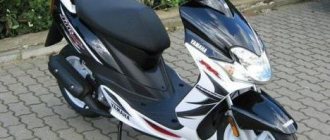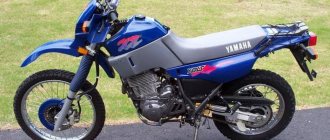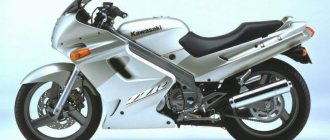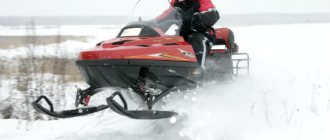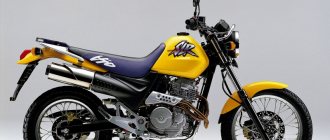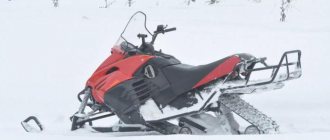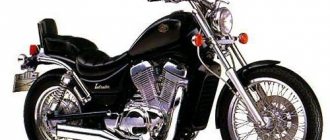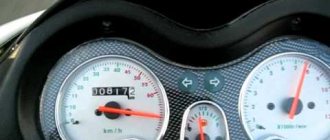Back in the middle of the 2022 season on the xjr400, I realized that it was not enough for me - the maximum speed was around 170+, it was extremely difficult to keep the cruiser at 150+ (namely, this was the speed at which my comrades usually rode along the track on 600s), plus There were some difficulties with overtaking long columns or trucks, because of which I often fell behind “my friends.” And the hijer himself is already noticeably outdated, both morally and physically. I wrote about its main technical shortcomings earlier, but among the moral ones I would classify the boring appearance of a classic road builder.
I came to the choice of the next motorcycle with the following requirements: - volume 600 - 800 cc; — power around 100 hp; — injector; — the most recent year of manufacture (from 2008); - beautiful, not boring, not like a hijer appearance (individual taste, of course); — comfortable fit for long trips (500+ km); — a sport or road worker with dimensions adequate for the city and between rows (I generally like sport tours like the VFR800, but they feel like a clumsy “cow” in traffic jams); — absence of serious “childhood sores” and reliability in operation; — full wind protection (that is, naked bikes are bypassed). Quite a few models fit these requirements, but the main part was quickly eliminated, and in the end I chose between the CBR 600 F4i, FZ6 S2 and XJ6 Diversion.
The CBR 600 F4i is the most comfortable sport (or even sport-touring) with a riding position that doesn't make my injured knee start to ache after half an hour of riding. It is he who leads in terms of comfort in my personal rating of 600 sports (then comes the ZX6R, and the last place is shared by the p6 and the jixer). And since my student years I have dreamed of CBR. In the end, I didn’t buy it - I couldn’t find an option suitable for the price and condition.
So, it’s almost mid-November 2022, all the interesting options in the nearest cities have been examined and I’m mentally prepared for the winter and changing my motorcycle in the spring.
At the same time, my vacation in Crimea was ending and just a couple of hours before departure, almost at night, the option to look at the 2010 FZ6 S2 suddenly appeared. And I really liked it - at first from the outside, and then when I tried to ride it, I realized: this is mine, this is exactly what I was looking for.
At the same time, at the time of inspection of the FZ6, I already had an agreement to watch the sabotage in another city. A very, very tasty diversion - 2011, abs, full plastic body kit, 3 hard cases included... and the price is the same as the FZ6. And yet... She seemed “cotton” to me. It starts, drives, twist the handle - it goes faster. But there is no sense of character. Xjr 400 was more fun, or something. (For comparison, a couple of days later I got my hands on a sabotage naked 2009, and it behaved completely differently - sharp, with a clear pickup at 4000, provoking aggressive driving and very comfortable in the city (especially after the phaser), since the dimensions the diversion is noticeably smaller and does not have a long and heavy plastic muzzle).
In general, on the very first weekend I picked up Phaser and drove him home. Almost 500 km in mid-November, of which 400 km were in continuous rain. On an unfamiliar motorcycle that has almost 2 times more power than my previous one. The trip was fun.
…400 days and 16,000+ km later…
Results and conclusions after the season on FZ6.
The Phaser has fully lived up to its reputation as an inexpensive (to maintain) and versatile motorcycle.
Quite maneuverable in the city and between the rows, quite powerful and responsive on the highway. It has really excellent standard wind protection - at 179 cm tall, I can ride with a completely straight landing even at 160 km/h, the wind does not bother me and does not drown out the music in the headset (and this is in a rather noisy helmet).
The most comfortable cruising speed is 150-160 km/h, in 6th gear this is average speed, 7-8 thousand. The red zone starts at 14,000, the real cutoff is about 14,500, and my maximum 230 km/h was at 12 - 12.5 thousand rpm).
On the highway, the Phaser (specifically the FZ6 S2) is simply very pleasant. I would say that it is intended for the track. At 150 km/h, even in 6th gear, there is enough power to pick up speed normally and not have problems with overtaking.
In the city, 3 gears are enough, 4 is needed if you want to save fuel and drive around 100 km/h at 4-5 thousand rpm. It is especially useful if you have direct flow and do not want to anger residents of residential areas. The stock exhaust is almost silent, but the engine is quite noisy.
Fuel consumption is very dependent on driving style. My record is less than 3.5 liters per 100 km, 6th gear, 110-130 km/h. I had to save money, since there were 68 km to refueling, and the reserve light (3.5 liters) had already come on. At the gas station I then filled up about 17 liters (tank capacity 19.4 liters according to BikesWiki).
On average, I use 1 tank for 250 km in the city in active driving mode.
If you drive along the highway “with all your money”, then at a speed of 170-200 km/h in 200 km the phaser consumed a little more than 15 liters.
The main problem is that it’s really hot on Fazer in the summer. And there are two reasons. In traffic jams, air from the engine goes to the legs, and even the manifold pipe runs directly under the seat, which creates additional heating for the butt. It's nice in cold weather, but definitely not in summer.
A month ago, I finally removed the exhaust and the first part of the “elbow” of the manifold, where the last catalyst is located - the exhaust was gutted, the partitions were removed and refilled, making a direct flow, and the pipe was wrapped in thermal tape, correcting the stupid heating of the ass. By the way, the brake fluid reservoir for the rear circuit is located next to the pipe and is heated by it. Apparently, a small engineering miscalculation, although even at +40 I did not feel that it was starting to overheat and there was no loss of braking quality.
At the beginning of last season (2018), an extraneous metallic sound appeared, which occurred above 6000 rpm and was very similar to the sound of a failed tensioner and a stretched timing chain: the source of the sound was exactly where it was located. Luckily it turned out to be not a chain, but a cage mount (crazy iron).
By the way, this is a kind of “arc/cage disease” on Phasers - due to vibration, the tightening of the bolts and nuts that tighten the cage weakens, strong vibrations appear on the steering wheel when the motorcycle warms up. In my case, the cells also began to ring after 6k revolutions.
It can be treated by periodically tightening the fasteners or using a thread locker (but I don’t recommend using a threadlocker - to change the oil, it’s easier to remove one half of the cage than to try to get to the oil filter).
The front fork is budget, without adjustments - you can adjust it either by changing the oil or replacing the springs. Some people put washers under the stock springs, but I’m not sure that this is a good solution - although they say it works. After half an hour of driving in the city, my arms and shoulders were tired and “clogged”, after which I disassembled the fork and filled in 10w oil (I saw in the manual that “factory oil” has a viscosity of both 5w and 10w, while people sometimes fill in 15w. And at the same time it doesn’t even knock out the seals, although I didn’t risk it). It became much better, even almost optimal. Lacks fine tuning, but oh well. Still not a track car. When I drained the oil from the fork, it seemed to me that it was still there from the factory in Japan - a greenish liquid poured out, which looked more like water than oil. I can say that it was exactly 5w based on my personal feelings about the stiffness of the fork before and after changing the oil.
There have been no serious interventions on the technical side of the motorcycle yet. In theory, I need valve clearances (the mileage is already 64,000, as if it’s time), but for now I still can’t muster up the courage to go to the service - I don’t want to go there myself.
After wintering, the fuses for the turn signal-side marker line suddenly started to burn. I haven't found the reason yet. They burn interestingly - not immediately, but after about 10-15 kilometers. There was a suspicion that after replacing the stock “shovel” with a different license plate mount, the turn signal wires were routed unsuccessfully - this was not confirmed. They also found a poorly insulated piece of wire that could short out when in contact with the frame (from the license plate light, which was completely removed) - this was not confirmed. So let's look further.
PS - Found the reason. And yet these are turn signals: when replacing the wiring, they laid it close to the exhaust, as a result the insulation melted and the wire periodically touched the frame, which burned the fuses.
And since I got to the electrics, at the same time as searching for the source of the short circuit, a high beam headlight was connected to work on the low beam (there are instructions in the phaser club, in fact, just a wire from the “low” headlight is thrown to the empty chip of the “high” headlight. BUT. There is a catch. If just throw in a wire, then 3 threads will light up on the high beam: low-low-high. And this is a crapshoot for the generator and can drain the battery if you drive below 5 thousand rpm for a more or less long time. Fixed with the help of a relay that is embedded in the line ). The second modification to the electrics is that the rear turn signals are connected as dimensions. Since I have diodes and are really bright, we decided the following: the lights are constantly on at about 1/3 of full brightness, and the turn signals work at full brightness. As a result, they “eat” very little, they are almost invisible during the day (although during the day they are not needed anyway, in fact), but at night they are clearly visible. At about 200 meters they are quite distinguishable. This calmed my paranoia that at night the dimensions of a motorcycle were not perceived as a motorcycle, and not a car with one non-functioning dimension.
Cost of owning a phaser per year
Consumables: 3 oil changes with filter ~ 7500 RUR; Air filter - 800 RUR; Antifreeze - 1350 RUR; Brake fluid (for all circuits) - 800 rubles; Changing the oil in the fork - 450 rubles; Front pads - 3200 rub.
Goodies: Stickers for wheels and tank - 1500 rubles; Short levers with ali - 1050 rubles; Frame for a number from Crazy Iron - 1350 RUR; Turn signals (glass donor for the original turn signal) - 600 rubles; Alarm ~13000 RUR; Cage repair - 2000 RUR; Polishing - 5000 rub; Direct flow and thermal tape - 7000 rubles; Electrical improvements - 2000 rub.
And a little more than a ton of burned fuel: motorcycling is, of course, fun, but it’s not cheap.
Below are just a few photos from our trips.
Model description
The Yamaha XJ6 motorcycle belongs to the middle class of equipment with engines up to 600 cubic centimeters. It joined the model line of the famous manufacturer in 2009.
The XJ6 model belongs to the naked class, designed for city streets, but it is good because it is universal and feels equally at home on highways and on country roads.
The new diamond frame design, made from high-strength steel tubing, precisely balances lateral stiffness for smooth cornering.
The four-row powertrain's tuning ensures low- to mid-range responsiveness that's ideal for spirited riding.
The chassis is compact, narrow, comfortable and lightweight with a low seat height and a modern design. Yamaha XJ6 motorcycles are suitable for both novice pilots and experienced drivers.
The tubular frame has reduced the dimensions of the motorcycle and its weight, which allows it to reliably follow a given trajectory. Even short riders can put their feet on the road when maneuvering at low speeds.
The instrument panel consists of an analogue tachometer and a multifunction display with a speedometer. The instruments are easy to read even at night, because, firstly, the tachometer needle is made with a luminescent coating, and secondly, the panel is illuminated with white LED backlighting.
It was produced in three colors - yellow (Extreme Yellow), black (Midnight Black) and white (Cloudy White).
Flaws
We talked about a comfortable fit, but if you are taller than 190 centimeters or heavier than 90 kilos, then this is out of the question. Moreover, with such physical indicators, not only will it be uncomfortable for you to sit on a motorcycle, but it will even be difficult to see anything in the rearview mirror.
The low seating position of the motorcycle sometimes leads to the rear footrest touching the asphalt surface when cornering, and the brackets that hold the footpegs are weak and bend easily. But this is a feature of the model, you just need to get used to it by slightly adjusting your driving style. Not very good front light is also a drawback, but it can be eliminated by replacing the lamp and fine-tuning the optics.
Details
What no vehicle can exist without is wheels. And, accordingly, without tires. They deserve the highest praise for this model - they have excellent grip properties, both on dry and wet asphalt. Another thing to note is the rear tire, which is much wider compared to other models. Due to it, high directional stability is ensured. There are two large, almost 300mm, discs that have twin-piston calipers from Akebono at the front and one at the rear from Nissan. This all indicates increased efficiency. From high speed the motorcycle settles down perfectly, and to add braking force you don’t need much – two fingers are enough. We can say that the motorbike remained almost the same model as the previous one, the one that all motorcyclists are used to seeing. This is a practical bike with a distinctly sporty feel and a slightly aggressive character, but with an undeniably individual look. The entire list of these advantages ends with excellent quality, which, in fact, is fully inherent in all models of this world-famous concern. This motorcycle simply cannot but please true connoisseurs of quality, harmoniously combined with a stylish appearance and excellent technical characteristics. The previous model earned a reputation as just such a motorbike, and in the Yamaha FZ6 all this was confirmed.
Appearance
It is worth noting that the Yamaha FZ6 motorcycle is very beautiful and good-looking. When a person sees it for the first time, the image of a sportbike, which seems to have been created by nature or the cosmos, will remain in his subconscious for a long time. The large, armor-like bike is covered with an aluminum openwork frame. It should be noted that it was created using special hydroforming technology. It consists of two halves, which are bolted together. The engine block, very short, sits very tightly in the frame - not the slightest gap is visible. It is impossible not to note the steering column with a stunningly beautiful headlight and a slightly offset electronic speedometer. The motorcycle also has composite chrome mirrors, which gives it even more extravagance. In addition, its rear part is also very interestingly designed - a two-level seat with handles made of plastic and steel, which is crowned with two exhaust pipes, made in an aggressive design.
Prices
The cost of a used model in our country starts at 250 thousand rubles. The average price of a motorcycle without mileage in Russia is from six thousand dollars. As a rule, the condition of imported motorcycles is much higher. But when buying at an auction abroad from home, you must understand that you are assessing the condition based on the photo. The Yamaha XJ6 is a reliable motorcycle, and motorcyclists abroad are responsible people, but there is a risk of running into a careless fraudster.
It is quite possible to find a decent motorcycle in our country with mileage throughout Russia. You need to thoroughly check the motorcycle before purchasing in order to know about all its subtleties and nuances. The surest option, if your funds allow you, is to personally go abroad to buy a motorcycle, choose the best one, bring it into Russia, go through customs clearance and then enjoy your new bike in perfect condition.
Restyling
All modifications of the model were restyled in 2013.
The changes affected the new design of the side panels of the motorcycle, and also modified the headlight fairing. The uncomfortable rear passenger handles, which many often complained about, have also been replaced. The backlighting of the “tidy” was made LED. Post-restyling models are not available in yellow. The seats were made from a different type of leather, the direction indicators received new lenses. Additionally, the model was equipped with a position indicator for the chain tension system.
In 2013, a limited edition of the XJ 6 SP Dark Menace motorcycles was released. The model differed from the standard version only in the stylish, eye-catching carbon fiber finish, as well as the “six” design on the fairings. The engine had no differences.
A new version
The new Yamaha XJ6 Diversion is a completely different motorcycle. It doesn't have the disadvantages of the first generation. And the price is very, very attractive. The model is perfect for beginner motorcyclists.
In general, the Yamaha XJ6 is a kind of variation of the Yamaha FZ6 (this unit has been sold in Europe instead of the XJ6 since 2009). In the American market, the XJ6 is called the Yamaha FZ6R. The appearance of the Yamaha XJ6 motorcycle in Europe is associated with the desire of the company's management to offer motorcyclists a low-power and budget model that would be aimed at the maximum number of potential buyers. The XJ6 is much cheaper in price, taxes and insurance than the original Yamaha FZ6 (98 horsepower engine).
It is worth noting that many manufacturers try to create very powerful and fast motorcycles, but for some reason they sometimes forget about transport for beginners. But this is more than it seems at first. This is a model for beginners, for girls, and for those who simply love measured motorcycle riding. It is very gratifying that at least someone produces real things for this large category of buyers.
Transmission and chassis
The engine is paired with a six-speed gearbox with constant mesh gears. The wheel drive is chain driven, with a lightweight 520 chain, which has a low braking effect.
The front suspension of the Yamaha XJ6 motorcycle uses a conventional telescopic fork, its travel is 13 cm.
The rear suspension is a Monocross pendulum narrow arm - made of a profile pipe with the same stroke as the front one.
The angle of inclination of the wheel rotation axis is 26°, and its offset is 10.4 cm.
The clutch is multi-disc oil, the starting system is starter, electric.
The braking system includes a 298mm dual disc front and a 245mm single disc brake with lightweight 4.5mm thick discs.
Light-alloy cast five-spoke wheels with a diameter of 17 inches are installed in sizes 120/70 on the front and 160/60 mm on the rear wheels of the Yamaha XJ6 motorcycle.

